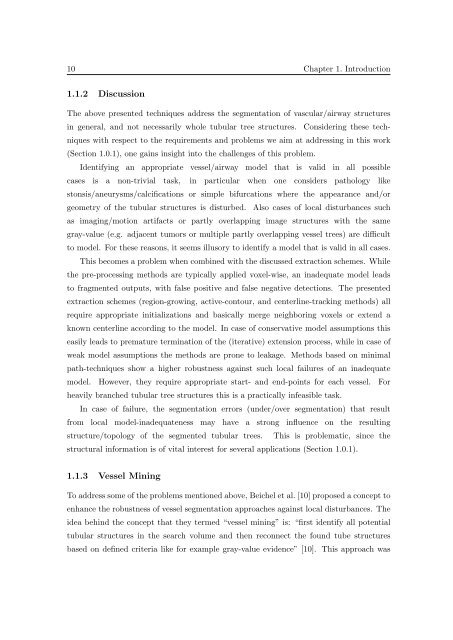Segmentation of 3D Tubular Tree Structures in Medical Images ...
Segmentation of 3D Tubular Tree Structures in Medical Images ...
Segmentation of 3D Tubular Tree Structures in Medical Images ...
You also want an ePaper? Increase the reach of your titles
YUMPU automatically turns print PDFs into web optimized ePapers that Google loves.
10 Chapter 1. Introduction<br />
1.1.2 Discussion<br />
The above presented techniques address the segmentation <strong>of</strong> vascular/airway structures<br />
<strong>in</strong> general, and not necessarily whole tubular tree structures. Consider<strong>in</strong>g these techniques<br />
with respect to the requirements and problems we aim at address<strong>in</strong>g <strong>in</strong> this work<br />
(Section 1.0.1), one ga<strong>in</strong>s <strong>in</strong>sight <strong>in</strong>to the challenges <strong>of</strong> this problem.<br />
Identify<strong>in</strong>g an appropriate vessel/airway model that is valid <strong>in</strong> all possible<br />
cases is a non-trivial task, <strong>in</strong> particular when one considers pathology like<br />
stonsis/aneurysms/calcifications or simple bifurcations where the appearance and/or<br />
geometry <strong>of</strong> the tubular structures is disturbed. Also cases <strong>of</strong> local disturbances such<br />
as imag<strong>in</strong>g/motion artifacts or partly overlapp<strong>in</strong>g image structures with the same<br />
gray-value (e.g. adjacent tumors or multiple partly overlapp<strong>in</strong>g vessel trees) are difficult<br />
to model. For these reasons, it seems illusory to identify a model that is valid <strong>in</strong> all cases.<br />
This becomes a problem when comb<strong>in</strong>ed with the discussed extraction schemes. While<br />
the pre-process<strong>in</strong>g methods are typically applied voxel-wise, an <strong>in</strong>adequate model leads<br />
to fragmented outputs, with false positive and false negative detections. The presented<br />
extraction schemes (region-grow<strong>in</strong>g, active-contour, and centerl<strong>in</strong>e-track<strong>in</strong>g methods) all<br />
require appropriate <strong>in</strong>itializations and basically merge neighbor<strong>in</strong>g voxels or extend a<br />
known centerl<strong>in</strong>e accord<strong>in</strong>g to the model. In case <strong>of</strong> conservative model assumptions this<br />
easily leads to premature term<strong>in</strong>ation <strong>of</strong> the (iterative) extension process, while <strong>in</strong> case <strong>of</strong><br />
weak model assumptions the methods are prone to leakage. Methods based on m<strong>in</strong>imal<br />
path-techniques show a higher robustness aga<strong>in</strong>st such local failures <strong>of</strong> an <strong>in</strong>adequate<br />
model. However, they require appropriate start- and end-po<strong>in</strong>ts for each vessel. For<br />
heavily branched tubular tree structures this is a practically <strong>in</strong>feasible task.<br />
In case <strong>of</strong> failure, the segmentation errors (under/over segmentation) that result<br />
from local model-<strong>in</strong>adequateness may have a strong <strong>in</strong>fluence on the result<strong>in</strong>g<br />
structure/topology <strong>of</strong> the segmented tubular trees. This is problematic, s<strong>in</strong>ce the<br />
structural <strong>in</strong>formation is <strong>of</strong> vital <strong>in</strong>terest for several applications (Section 1.0.1).<br />
1.1.3 Vessel M<strong>in</strong><strong>in</strong>g<br />
To address some <strong>of</strong> the problems mentioned above, Beichel et al. [10] proposed a concept to<br />
enhance the robustness <strong>of</strong> vessel segmentation approaches aga<strong>in</strong>st local disturbances. The<br />
idea beh<strong>in</strong>d the concept that they termed “vessel m<strong>in</strong><strong>in</strong>g” is: “first identify all potential<br />
tubular structures <strong>in</strong> the search volume and then reconnect the found tube structures<br />
based on def<strong>in</strong>ed criteria like for example gray-value evidence” [10]. This approach was















